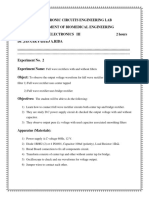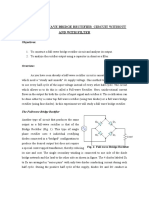Indian Institute of Technology Ropar Electrical Engineering Department
Uploaded by
rahul.23eez0004Indian Institute of Technology Ropar Electrical Engineering Department
Uploaded by
rahul.23eez0004Indian Institute of Technology Ropar
Electrical Engineering Department
Basic Electronics Lab (GE 108)
Lab exercise # 2
Title: To study rectifiers: HWR and FWR
Objective: 1) To construct a HWR and FWR rectifier circuits and analyse their outputs.
2) To analyse the rectifier outputs using a capacitor as a filter.
Components and equipments: A step-down transformer, 2PN junction diodes (1N 4007),
resistors (1K and 10K), Capacitor (100uF), Oscilloscope, Multimeters, Connecting wires,
Breadboard.
Introduction: Half-wave rectifier circuit is unsuitable to applications which need a "steady
and smooth" dc supply voltage. One method to improve on this is to use every half-cycle of
the input voltage instead of every other half-cycle. The circuit which allows us to do this is
called a Full-wave Rectifier. Here, unidirectional current flows in the output for both the
cycles of input signal and rectifies it. The rectification can be done either by a centre tap full
wave rectifier (using two diodes) or a full wave bridge rectifier (using four diodes).
In this experiment we will study ripple behaviour of HWR and FWR.
The ripple voltage i.e. Vr is given by Vr = [Vp/(f.RL.C)] where, Vp is peak output voltage,
RL is load resistance and C is filter capacitor.
Circuit Diagram :
Fig. 1 HWR if only upper-half of secondary is used and FWR if complete secondary is used
(Diode 1N 4007, Cap 100uF and Resistors 1K and 10K)
Lab exercise # 2 Page 1
Procedures:
i) Configure the half wave and full-wave rectifier circuit as shown in the circuit
diagram. Note down all the values of the components being used.
ii) Connect the primary side of the transformer to the a.c. Mains and secondary to the
input of the circuit.
iii) Feed the input and output to the oscilloscope
iv) Calculate the ripple factor and efficiency.
v) Connect the capacitor across the output for each load resistor. Measure the output
voltages once again and calculate the ripple factor.
Result: At the end of this lab exercise, one should be able to implement, analyse and
calculate parameters of full wave rectifier with and without capacitor.
1. For HWR :
Ripple voltage if R is 1K = ……………………. and 10 K= …………………………
2. For FWR :
Ripple voltage if R is 1K = ……………………. and 10 K= …………………………
Conclusion: To be written by students in record.
Lab exercise # 2 Page 2
Post-lab design questions:
1. When a 50Hz ac signal is fed to a rectifier, the ripple frequency of the output
voltage waveform for full bridge rectifier is
(a) 25 Hz (b) 50 Hz (c) 100 Hz (d)150 Hz
2. What is the PIV of a diode full wave bridge rectifier circuit?
3. What is the purpose of a filter in dc power supply?
4. For the figure shown below. Determine (a) the DC output voltage, (b) DC load
current, (c) the RMS value of the load current, (d) the DC power, (e) efficiency of
rectifier, (g) peak inverse voltage of each diode, and (h) output
frequency. Assume all diodes are ideal.
Lab exercise # 2 Page 3
You might also like
- Electronic Principles and Circuits Lab Manual - BEC303 - 18-11-202350% (2)Electronic Principles and Circuits Lab Manual - BEC303 - 18-11-202369 pages
- Basic Electronics Lab (Experiment 2 Report) : Submitted By: Group: G7 Ashutosh Garg (2018MEB1213) Ashwin Goyal (2018MEB1214)No ratings yetBasic Electronics Lab (Experiment 2 Report) : Submitted By: Group: G7 Ashutosh Garg (2018MEB1213) Ashwin Goyal (2018MEB1214)8 pages
- Reference Guide To Useful Electronic Circuits And Circuit Design Techniques - Part 2From EverandReference Guide To Useful Electronic Circuits And Circuit Design Techniques - Part 2No ratings yet
- Bel Assignment-3 Solution Sem-II 06032016 KarNo ratings yetBel Assignment-3 Solution Sem-II 06032016 Kar16 pages
- Reference Guide To Useful Electronic Circuits And Circuit Design Techniques - Part 1From EverandReference Guide To Useful Electronic Circuits And Circuit Design Techniques - Part 12.5/5 (3)
- Department of Electronics & Telecommunication: Presented By: Valluri Bhavana MSC - Etc, 1 Semester Roll No: Pg19Etc-002No ratings yetDepartment of Electronics & Telecommunication: Presented By: Valluri Bhavana MSC - Etc, 1 Semester Roll No: Pg19Etc-00222 pages
- Exp6HalfWaveRectifierdocx 2022 11 07 16 13 31No ratings yetExp6HalfWaveRectifierdocx 2022 11 07 16 13 314 pages
- Measurement of Ripple Factor For Full Wave RectifiersNo ratings yetMeasurement of Ripple Factor For Full Wave Rectifiers3 pages
- Presentation 16783 Content Document 20240312112538AMNo ratings yetPresentation 16783 Content Document 20240312112538AM52 pages
- Rectifier Circuits: 2.1 Experiments in Rectifiers 2.1.1 Aim of The ExperimentNo ratings yetRectifier Circuits: 2.1 Experiments in Rectifiers 2.1.1 Aim of The Experiment12 pages
- Design of Electrical Circuits using Engineering Software ToolsFrom EverandDesign of Electrical Circuits using Engineering Software ToolsNo ratings yet
- Ee 3101 Electronics I Laboratory Experiment 2 Lab Manual Power Supply Design ConsiderationsNo ratings yetEe 3101 Electronics I Laboratory Experiment 2 Lab Manual Power Supply Design Considerations8 pages
- Lab#3A: Full-Wave Bridge Rectifier Circuit Without and With FilterNo ratings yetLab#3A: Full-Wave Bridge Rectifier Circuit Without and With Filter6 pages
- Semiconductor Devices and Applications: EEE102L: Basic Electrical and Electronics EngineeringNo ratings yetSemiconductor Devices and Applications: EEE102L: Basic Electrical and Electronics Engineering44 pages
- Ecgr3155-Experiment 4-Diodes and Bridge RectifiersNo ratings yetEcgr3155-Experiment 4-Diodes and Bridge Rectifiers8 pages
- EXP 02 STUDY OF DIODE RECTIFIER CIRCUITS (1)No ratings yetEXP 02 STUDY OF DIODE RECTIFIER CIRCUITS (1)3 pages
- Electronics and Communication Circuits Lab. Experiment #4 Half-Wave and Full-Wave Bridge RectifierNo ratings yetElectronics and Communication Circuits Lab. Experiment #4 Half-Wave and Full-Wave Bridge Rectifier8 pages
- Exp_2 Halfwae & Fullwave Diode RectifierNo ratings yetExp_2 Halfwae & Fullwave Diode Rectifier11 pages
- Basic Electronics Lab: Laboratory ManualNo ratings yetBasic Electronics Lab: Laboratory Manual10 pages
- Revere 6820 Quartzoval Tungsten Halogen Floodlight 500w Bulletin 1966No ratings yetRevere 6820 Quartzoval Tungsten Halogen Floodlight 500w Bulletin 19662 pages
- Chapter 2 - Motherboard Components (Notes)100% (1)Chapter 2 - Motherboard Components (Notes)73 pages
- Benutzerhandbuch Owner's Manual Gebruikershandleiding: Stand 01/2005No ratings yetBenutzerhandbuch Owner's Manual Gebruikershandleiding: Stand 01/200518 pages
- The Power-Loss Analysis and Efficiency Maximization of A Silicon-Carbide MOSFET Based Three-Phase 10kW Bi-Directional EV Charger Using Variable-DC-Bus Control PDFNo ratings yetThe Power-Loss Analysis and Efficiency Maximization of A Silicon-Carbide MOSFET Based Three-Phase 10kW Bi-Directional EV Charger Using Variable-DC-Bus Control PDF6 pages
- Eaton RE Series IT Rack 27U-42U - DatasheetNo ratings yetEaton RE Series IT Rack 27U-42U - Datasheet2 pages
- КГМП SANDVIK TH 550 Dana 8821H-113 PBEA394061 RBEA431924No ratings yetКГМП SANDVIK TH 550 Dana 8821H-113 PBEA394061 RBEA43192454 pages
- Clutch: - Its Main Parts and Working Principle of ClutchNo ratings yetClutch: - Its Main Parts and Working Principle of Clutch6 pages
- Explore The Beauty of Dubai With MK Rent A Car RentalNo ratings yetExplore The Beauty of Dubai With MK Rent A Car Rental2 pages
- NPTEL - Week - 8 - v1 reevalution assignment solutionNo ratings yetNPTEL - Week - 8 - v1 reevalution assignment solution7 pages
- 2100.012 SHORTSTOPP 3-WAY Tee Plug W Guide BarsNo ratings yet2100.012 SHORTSTOPP 3-WAY Tee Plug W Guide Bars4 pages
- Aluminum Electrolytic Capacitors: SpecificationsNo ratings yetAluminum Electrolytic Capacitors: Specifications5 pages

























































































